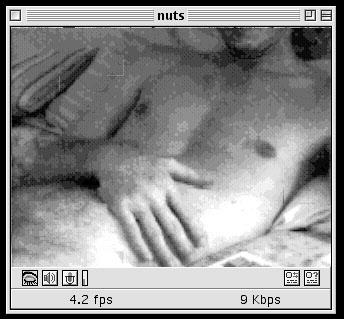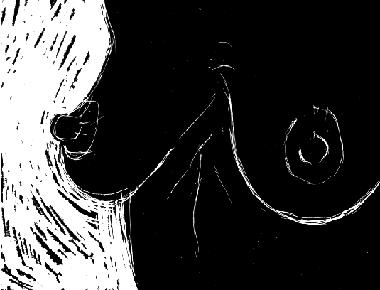Experiencing digital narratives, I found it interesting to identify some elements, we could say strategies, creating a proximity with the Net surfer. I believe that proximity has two important aspects. The first one is proximity in time, which I call immediacy. The second one is proximity in space, which I call contiguity. Both aspects are explored by artists in their digital artworks in many ways and from those resulted many different kinds of proximity. Here are some unachieved and fragmented thoughts on proximities in digital narratives.
Proximity and the personal computer
I believe watching an artwork in front of the personal computer and in the comfort of our home contributes to the experience of proximity. Personal computers are almost like friends to many of us. Personally, I don’t only do all of my work with my laptop, but a lot of my hobbies require that I use it. It is something I work with, play with, but also, it is sometimes my interface to my family and friends. I send emails and talk via Skype with this laptop. I also have a daily journal on it and it has many little scratches testifying its own “life”. We could say it has an “aura”!
Proximity and intimacy

Proximity is often associated to intimacy. If proximity can generate an experience of intimacy, the other way around is also true. On the Net, as we are in constant relation with the computer screen, topics related to intimacy are often used to create an experience of contact in real time. It’s not physically immersive but metaphorically, it is. In the digital narratives My Body and a Wunderkammerby Shelley Jackson as in Six Sex Scenes by Adrienne Eisen, the narrators speak in first person as if they were writing an intimate journal. This writing strategy creates contiguity, as the Net surfer becomes the narrator's confident. We enter the deep secrets of the characters coming of age, body transformations and sexual intercourses.

Tina Laporta, in her artwork intitled Distance, also explores the Net’s relationship through interactivity and webcam. She uses screenshots from CU-SeeMee, an Internet video-conferencing platform, to create her artwork. Sentences such as « he contemplates the nature of her presence » go hand in hand with the image of a man looking through a webcam. It brings us back to our position, to our presence and to our own intimate relation with the screen.
Proximity and the body

Jackson elaborates her narrative through an exploration of her body. As the narrator says, the body is like « a cabinet of wonders ». It becomes the interface by which we discover the forging identity of a person. Each body limb contains a bunch of souvenirs participating in the creation of a fragmented identity. We often hear that online experiences make us forget about the “tangible" world, especially because it makes us forget about our body. I believe using the body as a starting point, in a virtual environment, contributes to create tangibility and, furthermore, proximity. We can project our own body directly to this one which, in return, can be seen through the drawing and can be felt through the sensations described by the narrator.

Proximity and opacity
Many allusions in Jackson and Eisen’s immersive stories create, paradoxically, an opacity. This creates a strong blending between fiction and reality which, in return, is interesting in the experience of proximity. For example, Eisen writes: « The trees look real, but they're not, and neither are the birds, they're a recording. » Little sentences like this one make us conscious of the fiction we are reading. The opacity makes you realize your presence in front of the screen, here and now. It's also a privilege contact we the author.

Some artworks are almost totally opaques. Instead of absorbing you into the narrative of the screen, they invade your physical space, beyond the screen. That’s the case of Young Hae-Chang Heavy Industries artwork Dakota. Words and music, inspired by Ezra Pound’s Cantos, come up to the screen in such a way that it can be felt as an aggression. Sounds contribute to invade our space as they spread out of the screen. We don’t have time to think, sometimes we don’t even have time to read. There is no intimacy, but there is really another kind of proximity, in time and in space. Something comes and touches our retina without our intention. Intimacy, I believe, needs a certain distance in order to be fully experienced.
Proximity and mythical figures
Another way of creating a proximity is retelling a story everybody knows, a reference that touches us because we all have been raised with it. This is the case of Donna Leishman’s Redridinghood. Little Redridinghood is a mythical figure. She can be actualized in many mediums, many kinds of story; she has been reinterpreted through time. Reading a tale we’ve heard many times, we feel familiar with what we are in contact with. The artist actualizes it, making it present in space and time in another way.
See also : Mouchette
Proximity and Interactivity
In all of those artworks, the Net surfer has to click on images or words to explore it. This is not only a physical movement, of course, but it is often linked to our will. In Eisen, Laporta and Jackson’s narratives, hyperlinks connect the story. They also connect us with the story as we invest it with our own desires and thoughts. Young Hae-Chang Heavy Industries chose not to let us interact with the artwork and it actually gives way to a special effect. We feel that we loose control of our computer. We are clearly subjected to the artwork, our only power is to close our computer. We are used to control the interfaces. The absence of interactivity can be, then, a great strategy to create a proximity with the Net surfer...

